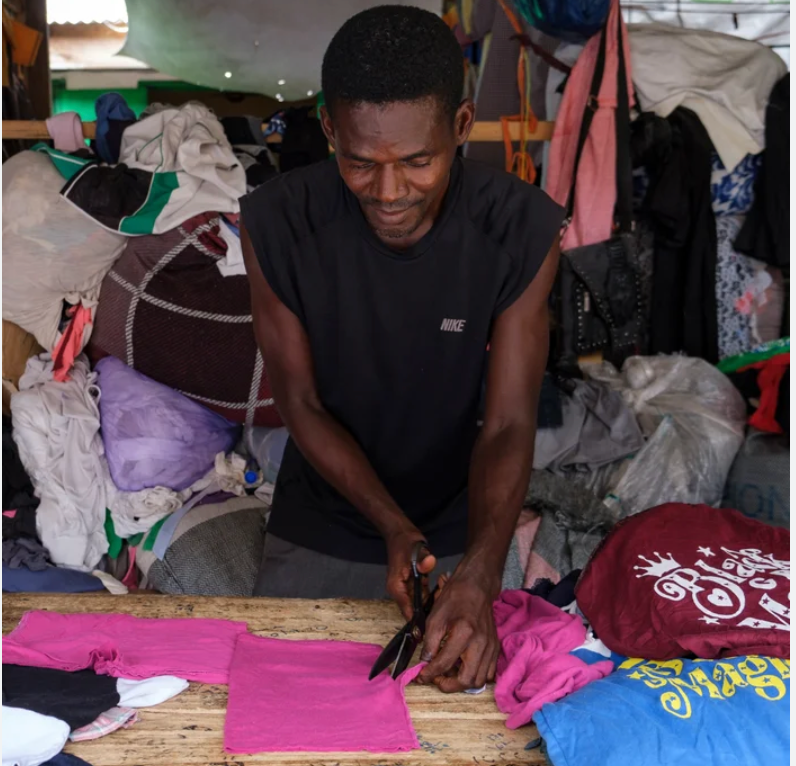The Art of Upcycling: Transforming Discarded Garments into Sustainable Fashion
In the heart of Accra, Zakiya Mahama’s workshop is a hub of creativity and innovation. As the rhythmic sound of sewing machines fills the air, old jeans are transformed into trendy patchwork designs, totes, and vibrant shopping bags. Faded jackets are dismantled and reborn as stylish accessories, while extra-large shirts become elegant suit covers. Each piece tells a story of sustainability, heritage, and reinvention.
Zakiya’s approach is rooted in resourcefulness. “I use what’s available—denim, jackets, secondhand shirts—and sometimes I batik over the fabric to make it even more unique,” she explains. “Then we combine that with clean formal cuts to create vibrant pieces that marry heritage with sustainability and proudly upcycled design.” With nimble fingers and a sharp eye for detail, she turns tattered garments into bespoke, fashion-forward pieces. Her brand, founded in Ghana, has grown into a powerful voice in both local and European sustainable fashion movements, championing the idea that fashion doesn’t have to cost the earth.
A Legacy of Creativity and Resourcefulness
Zakiya’s work is not just about fashion—it’s about preserving a long-standing tradition. For generations, Ghanaian tailors have patched, resized, re-hemmed, and reimagined imported clothing long before sustainability became a buzzword. Their skills have kept thousands of garments in circulation, saving families money while reducing waste.
Kwabena Amankwah, a tailor at Kantamanto Market, one of Africa’s largest secondhand clothing markets, echoes this sentiment. His small booth has stood on Lane Five for over two decades, weathering yearly fires. “My work is mostly alterations on men’s clothes—reducing size or length, patching holes,” he says. “I cut away a lot of fabric, which is cleared by the waste company, but I don’t know where it ends up.”
According to The Or Foundation, the volume of secondhand clothes imported annually into Ghana could fill 23 Accra Sports Stadiums, with nearly half considered waste due to its extremely low quality. However, the Ghana Used Clothing Dealers Association (GUCDA) places the figure at just five percent, highlighting the complexity and opacity of the trade.
Environmental Challenges and Hidden Dangers
The textile waste problem in Ghana is growing rapidly. Mr. Solomon Noi-Adzeman Nuetey, Director of Waste Management at the Accra Metropolitan Assembly, notes that textile waste has increased significantly over the last two decades due to declining product quality. “Much of what arrives today is simply not wearable. What can’t be sold or reused is dumped or burnt, and this contributes to greenhouse gas emissions, particularly carbon dioxide and black carbon,” adds Selina Amoah, Director of the Environmental Quality Unit at the EPA.
“It’s a hidden but potent source of pollution that must be addressed urgently.”
Despite these challenges, an informal ecosystem is thriving, breathing life into discarded garments. From repurposing to recycling, the sector presents major opportunities for green jobs and sustainable fashion entrepreneurship. Yet, these activities remain largely informal and underfunded.
Opportunities for Growth and Innovation
Kwabena Koomson-Grant, Communications Officer at The Or Foundation, highlights the need for access to machinery, training in textile design, and reliable sorting systems. “There are creatives ready to offer customers new experiences, but without financial and technical investment, the sector’s potential cannot be fully unlocked.” He explains that many artisans cut garments on their laps instead of using proper flat-cutting tables, making it harder to produce consistent quality comparable to new products.
At the root of the problem lies a fragmented supply chain, a lack of infrastructure, and a policy vacuum. Currently, Ghana has no comprehensive national framework for managing secondhand clothing waste or supporting circular fashion businesses. Abena Manso-Howard Gyamfi, a Senior Commercial Officer at the Ministry of Trade and Agribusiness, notes that although research has been completed, the main obstacle is investment to implement the study’s recommendations.
Circular Economy Solutions
The Ghana Circular Economy Centre (GCEC) project aims to address critical challenges within Ghana’s textile value chain by promoting sustainable practices aligned with circular economy principles. Mr. Joseph Yeboah, GCEC’s Strategic Partnerships and Engagements Lead, says the textile component of the project aims to reduce environmental degradation and economic inefficiencies associated with the importation of secondhand clothing and the widespread disposal of textile waste.
The five main pillars of the project include establishing a center of excellence for Ghana’s circular economy, providing training and building capacity, offering technical assistance to improve business models, supporting the financial sector to develop financial products for circular businesses, and facilitating networking and exchanges.
A Call for Action
Experts warn that time is running out. Without immediate policy action, Ghana’s thriving secondhand clothing sector could become an even larger environmental burden. Mr. Nuetey believes textile waste is now piling up in the ocean and calls for a scientific study to assess the scale of marine textile pollution.
The Ghana News Agency (GNA) recently helped recover 789 kilograms of textile waste during a beach clean-up, highlighting the hidden scale of the problem. To scale solutions like Zakiya’s, the Ministries of Trade, Agribusiness, and Local Government must collaborate to address unfair practices in the sector, where low-quality clothes are bundled and shipped to Ghana without proper inspection.
Both The Or Foundation and GUCDA are calling for a national policy on sustainable secondhand clothing trade. This policy would set import standards, promote repurposing industries, establish proper disposal protocols, and encourage Globally Accountable Extended Producer Responsibility (EPR).
For now, Zakiya and more than 20,000 like-minded tailors continue to transform discarded jeans into school bags, jackets, and joy despite little institutional support. “We are doing what we can,” she says. “But imagine what we could do with real support.”
As Ghana strives to meet its climate goals under the Paris Agreement, perhaps the most unlikely ally lies in a forgotten pair of jeans reimagined, repurposed, and ready to tell a new story.

